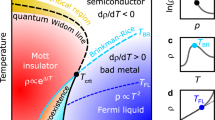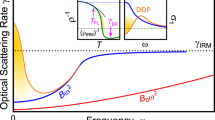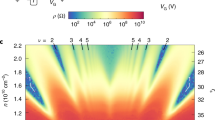Abstract
The discovery of the metal–insulator transition (MIT) in two-dimensional electron systems1 challenged the veracity of one of the most influential conjectures2 in the physics of disordered electrons, which states that ‘in two dimensions, there is no true metallic behaviour’; no matter how weak the disorder, electrons would be trapped and unable to conduct a current. However, that theory did not account for interactions between the electrons. Here, we investigate the interplay between the electron–electron interactions and disorder near the MIT using simultaneous measurements of electrical resistivity and magnetoconductance. We show that both the resistance and interaction amplitude exhibit a fan-like spread as the MIT is crossed. From these data, we construct a resistance–interaction flow diagram of the MIT that clearly reveals a quantum critical point, as predicted by the two-parameter scaling theory3. The metallic side of this diagram is accurately described by the renormalization-group theory4 without any fitting parameters. In particular, the metallic temperature dependence of the resistance sets in when the interaction amplitude reaches γ2≈0.45—a value in remarkable agreement with the one predicted by theory4.
Similar content being viewed by others
Main
The low amount of disorder in high-mobility silicon metal-oxide–semiconductor field-effect transistors (Si MOSFETs) allows measurements to be made in the regime of very low electron densities where correlation effects due to electron–electron interactions become especially important. (Ratios rs≡EC/EF>10 between Coulomb and Fermi energies are easily reached with Fermi energies of the order 0.7 meV.) This material system has the further advantage that its electron spectrum has two almost degenerate valleys, which further enhances the correlation effects. Indeed, the low-temperature drop of the resistance on the metallic side of the transition (Fig. 1a) in Si MOSFETs is the most pronounced among all two-dimensional (2D) electron systems5,6.
a, ρ(T) traces at B=0. b, Ce e(T), extracted from the slope of the magnetoconductance (see text). Both ρ(T) and Ce e(T) exhibit a fan-like structure across the MIT. The densities (in units of 1010 cm−2) are: 7.24, 7.53, 7.83, 8.26, 8.70, 9.14, 9.58 and 9.87. In a, the densities increase from top to bottom, whereas in b, they increase from bottom to top, that is, the interaction increases in the metallic phase and decreases in the insulating phase as the temperature is lowered. M and I regions indicate metallic and insulating phases, respectively.
At low temperatures kBT<ℏ/τ<EF, electrons propagate diffusively. Here, kB is Boltzmann’s constant, T is temperature and τ is the electron mean free time. This region, referred to as the diffusive regime, extends up to a few kelvin near the metal–insulator transition (MIT). As a result, the low-temperature physics of the disordered electron liquid, combined with the large rs values near the MIT, is determined by the properties of interacting, diffusing electrons7,8,9.
With this in mind, and with the view of studying the role of disorder and effective strengths of the electron interactions in the vicinity of the MIT, we have carried out simultaneous measurements of the resistivity, ρ, and in-plane magnetoconductance, σ(B). As the origin of the magnetoconductance lies in the interaction corrections to the conductance involving different spin projections (Hartree-like), the corresponding interaction strength can be determined from the slope of σ(B). When a magnetic field, B, is applied parallel to the 2D plane in the diffusive regime10,11, the magnetoconductance Δσ(B,T)≡σ(B,T)−σ(0,T) is proportional to b2 in the weak-field limit b≡g μBB/kBT≪1, where μB is the Bohr magneton. On the other hand, at higher temperatures ℏ/τ<kBT<EF, referred to as the ballistic regime, Δσ(B,T) is expected to be proportional to T b2 (ref. 12). Because the magnetoconductivities in these two regions are so different, measuring Δσ(B,T) provides a reliable way to identify the diffusive region.
The samples we used had peak electron mobilities of about 3×104 cm2 V−1 s−1 at 0.2 K. The resistivity, ρ, was measured by a standard low-frequency lock-in technique. The magnetoresistance traces, ρ(B), for a representative density in the diffusive region ns=9.14×1010 cm−2, are plotted in Fig. 2a for different temperatures; ρ(T) at B=0 for this density is the third curve from the bottom in Fig. 1a. The corresponding magnetoconductivities, Δσ=1/ρ(B)−1/ρ(0), are plotted as function of b2 in Fig. 2b. When plotted this way, it can be seen that the σ(b2) curves are linear. It can also be seen that the slopes decrease slowly with temperature. This is important, because had the electrons been in the ballistic regime, the slopes would have instead increased with temperature by an order of magnitude in the temperature interval used owing to the expected T b2 dependence. By applying the same procedure to different electron densities, we find that the diffusive region extends to approximately 25% in electron densities above the critical density of the MIT. (The critical density nc≈8×1010 cm−2 in this sample.)
a, Resistivity plotted against magnetic field applied parallel to the 2D plane. b, Magnetoconductivity Δσ(B,T)≡σ(B,T)−σ(0,T) (in units of the quantum conductance) plotted as a function of (g μBB/kBT)2. The curves in b are vertically shifted for clarity. Note that the curves for different temperatures are linear when plotted versus (g μBB/kBT)2 and their slopes slowly decrease with temperature.
The explicit form of the slope of Δσ(b2) for the single-valley case was derived in refs 10, 11. It is straightforward to accommodate the valley degrees of freedom. For the case of nv degenerate valleys (nv=2 for silicon), we obtain for Δσ(b2), in the limit b≪1, the expression

(We note that the constant 0.091 in equation (1) provides a more accurate coefficient compared with the value 0.084 given in ref. 10.) Here, γ2 is the effective electron–electron interaction amplitude in the spin-density channel. (In standard Fermi-liquid notation, γ2 is related to the parameter F0a as γ2=−F0a/(1+F0a).) As was observed earlier in ref. 4, the large factor nv2 due to the valleys enhances the effect of the e–e interactions. (Here, we have assumed that the valleys are fully degenerate at all temperatures by restricting ourselves to T>Tv, where Tv is the temperature scale associated with the valley splitting. This temperature is not precisely known, but our analysis of the low-temperature data suggests Tv≈0.5 K. Further details of this region will be presented elsewhere.)
Equation (1), as was shown in ref. 11, incorporates renormalization-group corrections to first order in ρ and is therefore strictly valid only deep in the metallic region. For general ρ, the magnetoconductance in the diffusive regime will still retain the b2 form, Δσ=−(e2/πh)Ce e(γ2,ρ)nv2b2. The coefficient Ce e reflects the strength of spin-related interactions at any value of the resistance (as long as g μBB<kBT<h/τ). This is because the in-plane magnetoconductance is a consequence of the splitting of the spin sub-bands. The fluctuations in spin density lead to finite temperature corrections to the resistivity via the electron–electron interaction amplitude in the spin-density channel, γ2. Thus, the spin splitting, by reducing these fluctuations, leads to a finite magnetoconductance through γ2.
The temperature dependences of the parameter Ce e, extracted by fitting the σ(b2) traces in Fig. 2b, are shown in Fig. 1b for various densities across the MIT. To the best of our knowledge, this is the first observation of the temperature dependence of the strength of the electron–electron interactions. In Fig. 1a, we plot ρ(T) at zero magnetic field for the same densities. (In the following, ρ is always expressed in units of πh/e2 (ref. 3).) Figure 1 reveals that not only ρ but also the interaction strength exhibits a fan-like spread as the MIT is crossed. We see that, whereas the interaction grows in the metallic phase as the temperature is reduced, it is suppressed in the insulating phase. The magnitudes of these changes depend on how far the system is from the MIT, with both ρ and γ2 becoming practically temperature independent for densities close to the MIT. This behaviour is indicative of the flow around a quantum critical point (QCP), which is fully consistent with the theoretical prediction that the evolution of ρ and the interaction amplitude, γ2, with temperature are described by a two-parameter system of coupled renormalization-group equations manifesting an unstable fixed point corresponding to the QCP3. Note that a phase diagram can be presented in different coordinates obtained as a result of various (rather broad) transformations, preserving the topology of the phase diagram. In our case, the transformation involves using the slope of the magnetoconductance.
To see this in a different way, we combine Fig. 1a and b and construct a two-parameter ‘flow’ diagram in the disorder–interaction (ρ–Ce e) space. The flow diagram is shown in Fig. 3. It can be seen that such a flow diagram constructed out of ρ and the parameter Ce e (which is sensitive to the amplitude γ2) clearly indicates the existence of a QCP from which three separatrices, one attractive and two repulsive, can be drawn.
On the metallic side of the flow diagram, a separatrix that forms the envelope of a family of non-monotonic curves can be clearly seen in Fig. 3 flowing towards the region with ρ≪1. The theoretical details of the evolution of ρ and the γ2 in this region with ρ≪1 were discussed in detail in ref. 4 in terms of a renormalization-group theory. We recall the salient features of the theory here. The theory predicts that: (1) the amplitude γ2 increases monotonically as the temperature is reduced; (2) the resistance, on the other hand, has a characteristic non-monotonic form changing from insulating behaviour (dρ/dT<0) at high temperatures to metallic behaviour (dρ/dT>0) at low temperatures, with the maximum value, ρmax, occurring at a crossover temperature T=Tmax; (3) the value of the amplitude γ2 at T=Tmax is universal in the limit ρmax≪1, depending only on nv; for nv=1, it is 2.08, whereas for nv=2, it has the much lower value 0.45; (4) although the values of ρmax and Tmax are not universal and depend on the system, the behaviours of ρ(T)/ρmax and γ2(T) are universal when plotted as functions of ρmaxln(T/Tmax).
The results of comparison between experiment and theory are shown in Fig. 4a,b, for the three largest densities in the diffusive regime with ρmax≲0.4 (πh/e2). At these densities, the resistance is small enough, and we can safely extract the interaction amplitudes γ2 from Δσ(b2) using equation (1), that is, Ce e=0.091γ2(1+γ2). (As the density increases, the maximum in ρ(T) becomes less pronounced, and the non-monotonicity eventually disappears at ns≳1×1011 cm−2, as the ballistic region is approached.) The solid lines are the universal theoretical curves for ρ(T)/ρmax and γ2(T) plotted as a function of ρmaxln(T/Tmax). It can be seen from Fig. 4 that at T=Tmax, the value of the interaction amplitude γ2≈0.45, which is in remarkable agreement with theory for nv=2. The agreement between theory and experiment is especially striking given that the theory has no adjustable parameters. Systematic deviations from the universal curve occur at lower densities as higher-order corrections in ρ become important.
a, ρ/ρmax as a function of ρmaxln(T/Tmax). b, γ2 as a function of ρmax ln(T/Tmax). The vertical dashed lines correspond to T=Tmax, the temperature at which ρ(T) reaches the maximum. Note that at this temperature, the interaction amplitude γ2≈0.45 (indicated by the horizontal dashed line in b), in excellent agreement with theory. The symbols are the same as in Figs 1 and 3 and correspond to ns=9.87, 9.58 and 9.14×1010 cm−2.
The data for γ2 allow us to calculate the renormalized Landé g-factor g*=2(1+γ2). For our highest density sample, it grows from g*≈2.9 at the highest temperature to g*≈4 at the lowest. This is the first time the g-factor has been measured in the diffusive regime and is seen to increase with decreasing temperature. Earlier experiments were done in the ballistic regime, where the g-factor was found to be g*≈2.8 and temperature independent13.
Finally, we would like to note that the 2D electron system in silicon, used in this study, has a short-range disorder potential and constitutes a multi-valley system: features assumed in the theory. In other material systems, including GaAs/AlGaAs heterostructures and SiGe heterostructures, the disorder potential is long range, which leads to very high mobilities. The diffusive regime in these systems is therefore hard to reach at reasonable temperatures. In addition, high mobilities also imply very low carrier densities, which leads to a plethora of finite temperature corrections arising from non-degeneracy effects, large-rs screening effects and so on. Therefore, the transition observed so far in these systems (see, for example, refs 14, 15) might be a ‘high’-temperature crossover phenomenon. Ultimately, however, at low enough temperatures the diffusive regime will unavoidably be reached. It remains to be seen whether or not the low-temperature behaviour in other 2D systems is quantitatively described by the two-parameter scaling theory.
References
Kravchenko, S. V. et al. Possible metal–insulator transition at B=0 in 2 dimensions. Phys. Rev. B 50, 8039–8042 (1994).
Abrahams, E., Anderson, P. W., Licciardello, D. C. & Ramakrishnan, T. V. Scaling theory of localization: Absence of quantum diffusion in two dimensions. Phys. Rev. Lett. 42, 673–676 (1979).
Punnoose, A. & Finkel’stein, A. M. Metal–insulator transition in disordered two-dimensional electron systems. Science 310, 289–291 (2005).
Punnoose, A. & Finkel’stein, A. M. Dilute electron gas near the metal–insulator transition: Role of valleys in silicon inversion layers. Phys. Rev. Lett. 88, 016802 (2002).
Kravchenko, S. V. & Sarachik, M. P. Metal–insulator transition in two-dimensional electron systems. Rep. Prog. Phys. 67, 1–44 (2004).
Shashkin, A. A. Metal–insulator transitions and the effects of electron–electron interactions in two-dimensional electron systems. Phys.-Usp. 48, 129–149 (2005).
Finkel’stein, A. M. Influence of Coulomb interaction on the properties of disordered metals. Sov. Phys.—JETP 57, 97–108 (1983).
Castellani, C., Di Castro, C., Lee, P. A. & Ma, M. Interaction-driven metal–insulator transitions in disordered fermion systems. Phys. Rev. B 30, 527–543 (1984).
Finkel’stein, A. M. in Electron Liquid in Disordered Conductors (ed. Khalatnikov, I. M.) (Soviet Scientific Reviews, Vol. 14, Harwood Academic Publishers, London, 1990).
Lee, P. A. & Ramakrishnan, T. V. Magnetoresistance of weakly disordered electrons. Phys. Rev. B 26, 4009–4012 (1982).
Castellani, C., Di Castro, C. & Lee, P. A. Metallic phase and metal–insulator transition in two-dimensional electronic systems. Phys. Rev. B 57, 9381–9384 (1998).
Zala, G., Narozhny, B. N. & Aleiner, I. L. Interaction corrections at intermediate temperatures: Magnetoresistance in a parallel field. Phys. Rev. B 65, 020201 (2002).
Anissimova, S. et al. Magnetization of a strongly interacting two-dimensional electron system in perpendicular magnetic fields. Phys. Rev. Lett. 96, 046409 (2006).
Huang, J., Novikov, D. S., Tsui, D. C., Pfeiffer, L. N. & West, K. W. Non-activated transport of strongly interacting two-dimensional holes in GaAs. Phys. Rev. B 74, 201302(R) (2006).
Lai, K. et al. Linear temperature dependence of conductivity in Si two-dimensional electrons near the apparent metal-to-insulator transition. Phys. Rev. B 75, 033314 (2007).
Acknowledgements
We acknowledge useful discussions with E. Abrahams, C. Castellani, C. Di Castro and M. P. Sarachik. The work at Northeastern University was supported by the NSF grant DMR-0403026. A.P. was supported in part by the PSC-CUNY grant no. 60062-3738. A.M.F. is supported by the Minerva Foundation.
Author information
Authors and Affiliations
Contributions
The experiments were carried out by S.A. and S.V.K.; A.P. and A.M.F. were responsible for the theoretical analysis and T.M.K. provided the samples. All authors contributed to writing the manuscript.
Corresponding author
Ethics declarations
Competing interests
The authors declare no competing financial interests.
Rights and permissions
About this article
Cite this article
Anissimova, S., Kravchenko, S., Punnoose, A. et al. Flow diagram of the metal–insulator transition in two dimensions. Nature Phys 3, 707–710 (2007). https://doi.org/10.1038/nphys685
Received:
Accepted:
Published:
Issue Date:
DOI: https://doi.org/10.1038/nphys685
This article is cited by
-
Metal-insulator transition in two-dimensional transition metal dichalcogenides
Emergent Materials (2021)
-
Transport evidence for a sliding two-dimensional quantum electron solid
Nature Communications (2018)
-
Possible Magnetic Background of the Metal-Insulator Transition in Two-Dimensional Correlated Electron System
Journal of Superconductivity and Novel Magnetism (2017)
-
Disordered RuO2 exhibits two dimensional, low-mobility transport and a metal–insulator transition
Scientific Reports (2016)
-
Functionalized graphene as a model system for the two-dimensional metal-insulator transition
Scientific Reports (2016)







